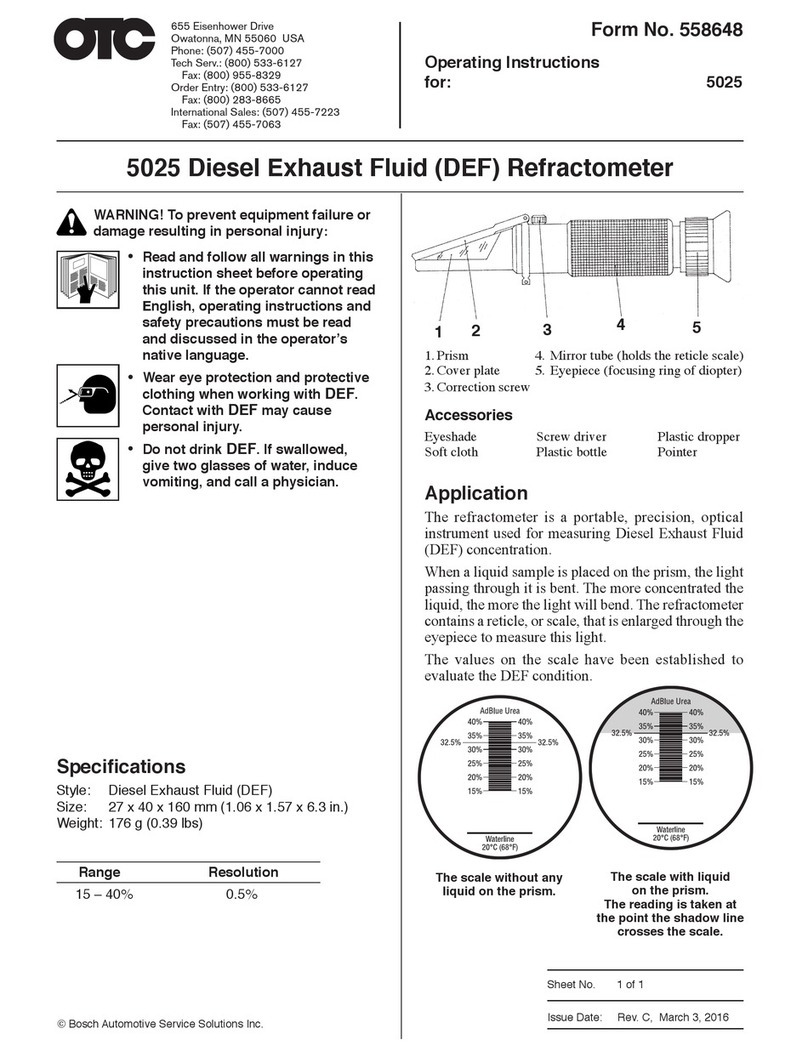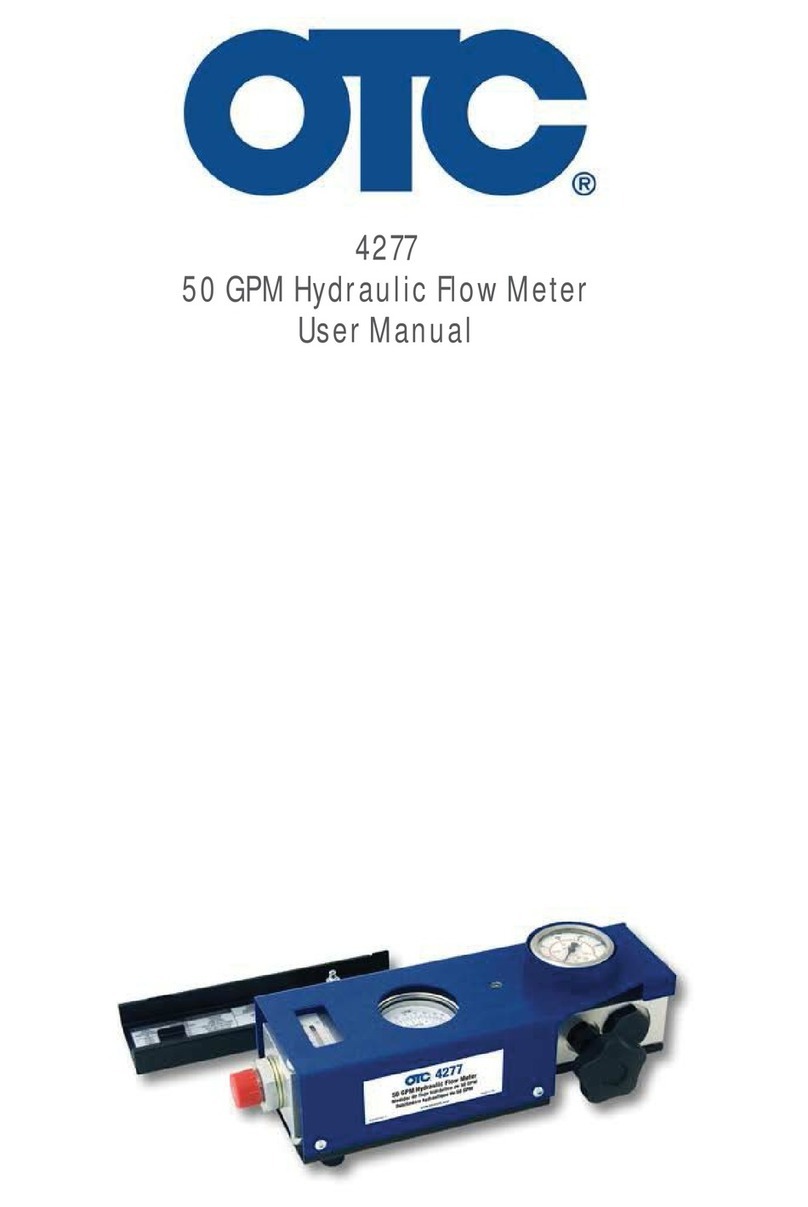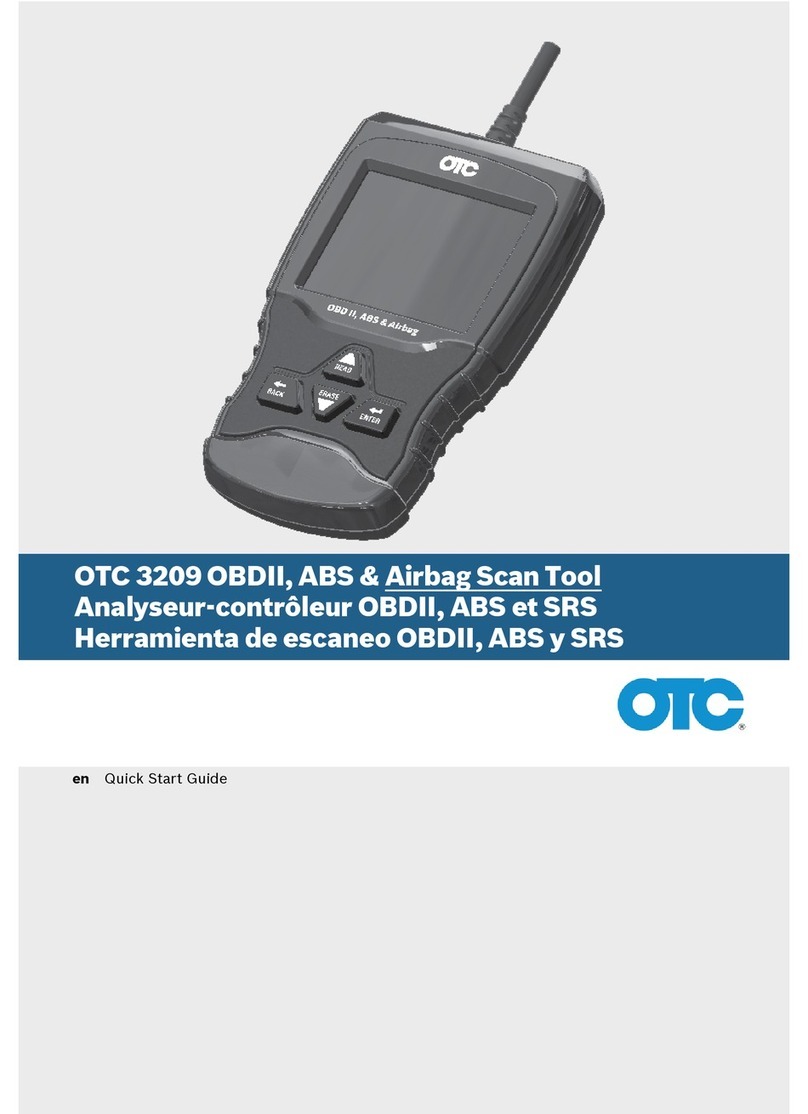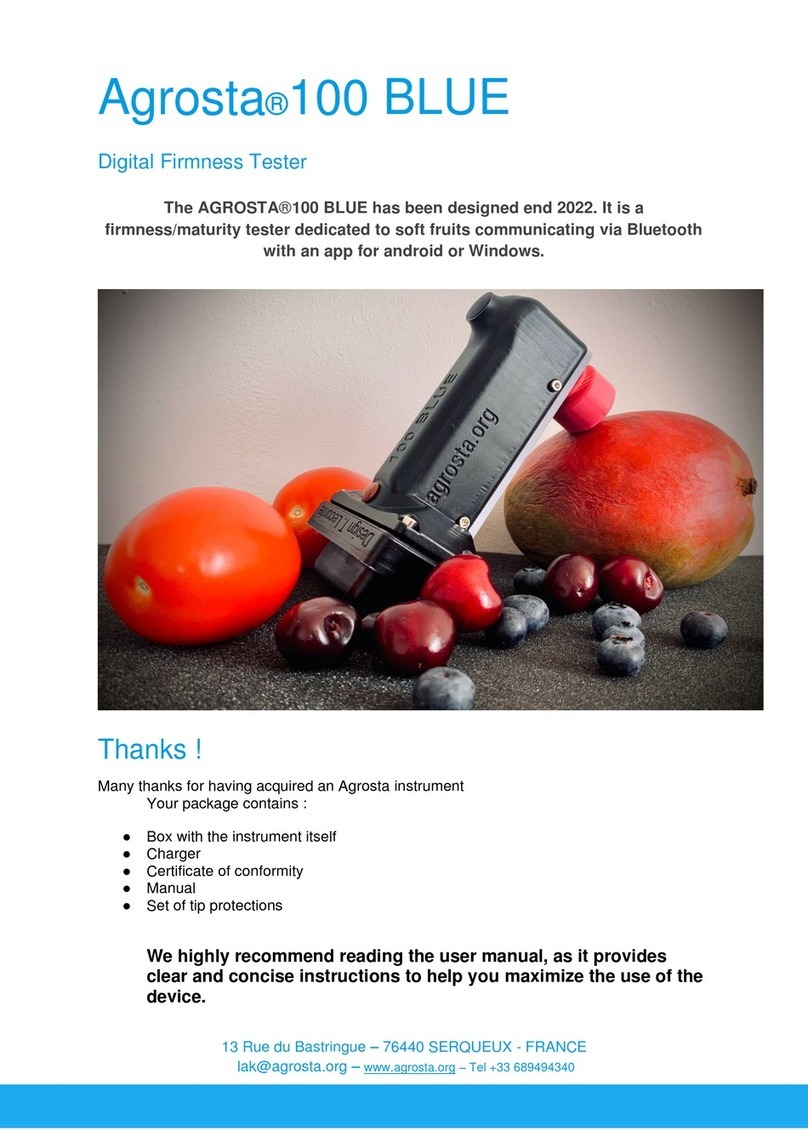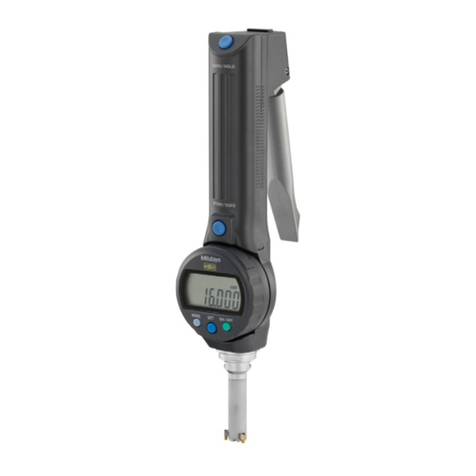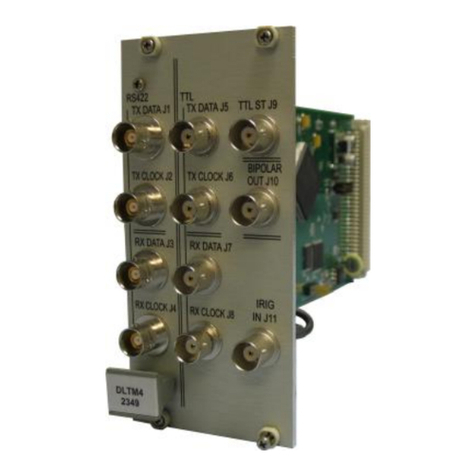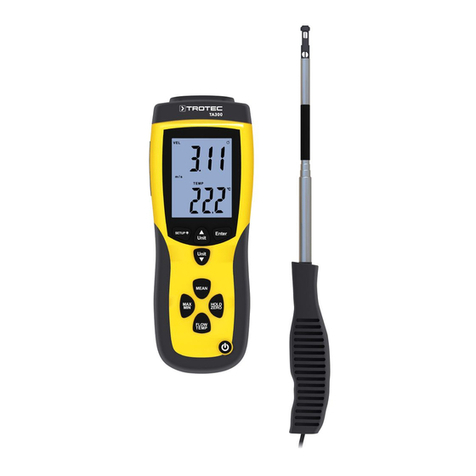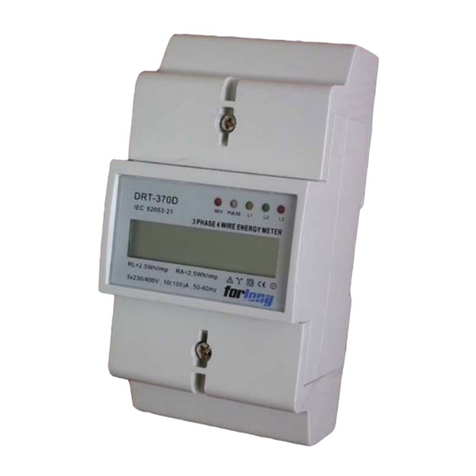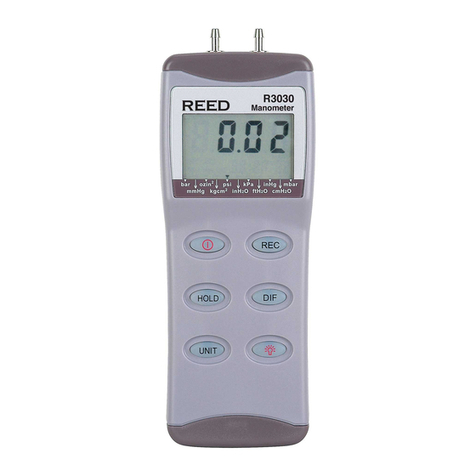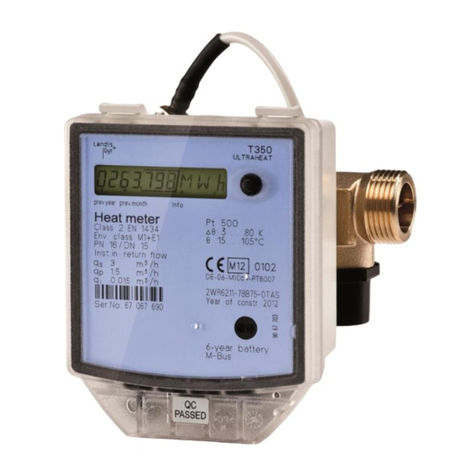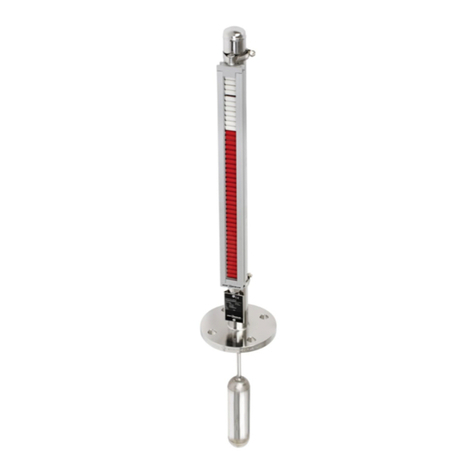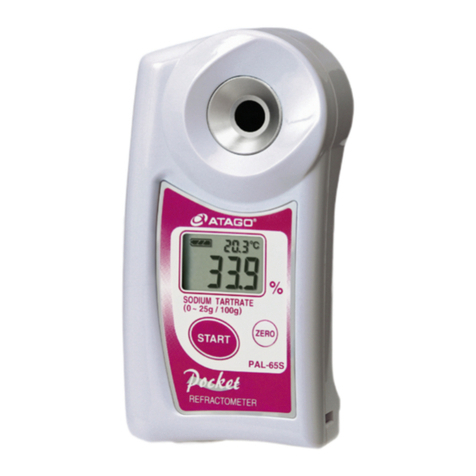OTC 4278 User manual

EnglishFrançaisEspañol
1
4278
100 GPM Hydraulic Flow Meter
User Manual

English
1
Introduction
The OTC 4278 Hydraulic Flow Meter has been designed for easy connection to a hydraulic
circuit so that flow, pressure and temperature can be readily checked. The Flow Meter can
take full back pressure up to 6000 psi (420 bar), and the built-in loading valve enables many of
the operating conditions to be simulated. The unit can be connected anywhere in the hydraulic
system to test pumps, motors, valves and cylinders in both flow directions.
Safety Precautions
CAUTION: To prevent injury and / or property damage,
lStudy, understand, and follow all safety precautions and operating instructions before
using this equipment. If the operator cannot read instructions, operating instructions
and safety precautions must be read and discussed in the operator’s native language.
lNo alteration shall be made to this product.
lInspect the condition of the equipment before each use; do not use if damaged,
altered, or in poor condition.
lEnsure load valve is fully open prior to testing.
lWear eye protection that meets the standards of ANSI Z87.1 and OSHA.

English
2
Basic operation
Flow measurement
The unit measures flow using an axial turbine mounted in the aluminum base block. The oil flow
rotates the turbine and its speed is proportional to the oil velocity. The revolutions of the turbine
are measured by means of a magnetic sensing head which feeds a pulse every time a turbine
blade goes by to an electronic circuit. The electronic circuit has a built-in micro processor; the
signal is amplified and linearised to maximise accuracy.
Pressure gauge
The pressure gauge has a spiral Bourdon tube and the gauge case is filled with glycerine to
ensure good dampening on pulsating pressures. The gauge is connected to the turbine block
by a fine bore capillary tube. The unit gauge has a shuttle valve which automatically reads
the highest pressure in both directions of flow. A gauge port is provided on the block for the
addition of a low pressure gauge.
Temperature
The thermistor temperature transducer is in contact with the oil flow and readout is on the
meter scale calibrated 32 - 250°F or 0 - 120°C.
Bi-Directional Loading Valve
The reverse flow valve gives positive shut-off and pressure control in both directions of flow.
The loading valve has two easily replaceable burst discs located in the valve assembly which
internally protect the unit and machine in both flow directions.
Installation guidance
lAll hydraulic connections should be made by suitably qualified personnel.
lAvoid sharp bends because high pressure hoses will deflect and straighten under pressure.
lA preliminary check of the hydraulic system’s oil supply, pump rotation, filters, oil lines,
cylinder rods as well as looking for external leaks should be made prior to installing the unit.
lAlthough the unit can be used in both flow directions, the preferred direction is indicated by
the larger arrow on the panel. When used for reverse flow tests, slightly lower accuracies
may be obtained depending on the oil viscosity, density and compressibility.
lThe unit should be connected to the hydraulic circuit by means of flexible hoses 3 - 6 ft
(1 - 2 metres) metres long.
lThe use of quick-disconnect couplings can save time. Make sure the hoses are long enough
so that the unit can be used safely on the machine.
lThe hoses and fittings at the inlet must be of adequate size for the flow being tested.
Elbows, rotary couplings etc., at the inlet and outlet ports should be avoided to ensure
accurate readings.
lThe use of the flexible hoses will help to isolate the unit from vibration which often exists.
lThe internal burst discs are to protect the unit not the hydraulic installation. Always ensure
the appropriate relief devices are fitted to protect the installation.

English
3
General Operation
All tests should be performed by suitably qualified personnel.
1. Connect the unit to the circuit (see previous page for installation guidance).
2. Ensure the pressure loading valve is fully opened by turning the knob counterclockwise.
3. Switch the unit on. If the display ashes, then the battery needs replacing.
4. Select the desired test using the front panel controls where applicable.
5. IMPORTANT: Ensure all connections are tightened and the oil can flow freely throughout
the hydraulic system BEFORE running the machine at full speed. Check that the circuit is
correctly connected and any shut-off valves are opened. Quick disconnect couplers MUST
be open.
6. Start the pump momentarily to ensure there is no obstruction which could cause pressure
build up.
7. Check for leaks and free flow of oil.
8. The unit is now ready for use - run the machine and adjust the loading valve as needed.
9. When the test is completed fully open loading valve.
Notes
When low pressure testing is required, connect the optional low pressure gauge with automatic
cut-out valve to the flow block.
The unit has an automatic electronic system which shuts the power o after approximately 20
minutes should you forget. To reactivate, switch the unit o then switch on again.

English
4
Specification
Dimensions and Weight
Model Height Width Depth Weight
4278 9.45”(240 mm) 7.87”(200 mm) 7.87”(200 mm) 14.33 lbs (6.5 kg)
* per J518 SAE Code 61 standard
Model Number Flow Range Pressure Range Inlet/Outlet Ports
4278 2.5 - 100 gpm 0 - 6000 psi 1-5/16”-12UN #16 SAE ORB
(10 - 400 lpm) (0 - 420 bar)
Ambient temperature: 41 - 104°F (5 to 40°C)
Fluid type: Hydraulic oil
Fluid temperature: 32 - 250°F (0 to 120°C)
Flow Accuracy: ± 1% of full scale.
Pressure Accuracy: ± 1.6% of full scale.
Temperature Accuracy: ± 2°F, 1°C.
Construction materials
Case: Painted mild steel
Flow block: High tensile aluminum
Seals: FKM
Battery Details
PP3 9 volt Alkaline (IEC6LR61, ANSI/NEDA 1604A)
Fluid type
Temp °C ISO15 ISO22 ISO32 ISO37 ISO46 ISO68
0 85.9 165.6 309.3 449.9 527.6 894.3
10 49.0 87.0 150.8 204.7 244.9 393.3
20 30.4 50.5 82.2 105.5 127.9 196.1
30 20.1 31.6 48.8 59.8 73.1 107.7
40 14.0 21.0 31.0 36.6 44.9 63.9
50 10.2 14.7 20.8 23.9 29.4 40.5
60 7.7 10.7 14.7 16.5 20.2 27.2
70 6.0 8.1 10.9 12.0 14.6 19.2
80 4.8 6.4 8.4 9.1 11.1 14.3
90 4.0 5.2 6.6 7.2 8.7 11.1
100 3.3 4.3 5.5 6.0 7.1 8.9
Table showing kinematic viscosity (cSt) of different mineral oils at specific temperatures
ISO 15, 22, 32, 46 and 68 based on typical figures for the Esso Nuto range of
HM oils. ISO 37 based on Shell Tellus HM oil.
Fluid viscosity
The performance of a turbine flow meter can be affected by the viscosity of the fluid measured.
Our turbine flow meters are calibrated at between 18 and 26 cSt as standard (a mean viscosity
of 21 cSt), which is the typical kinematic viscosity for a hydraulic fluid operating at 50 °C. The
kinematic viscosity of all hydraulic fluids is related to the fluid temperature and the table below
shows the affect of temperature on the kinematic viscosity of a range of typical grades of
hydraulic oil.
The shaded area of the table shows the range of viscosities that can be measured by a flow
meter with standard calibration with minimal effect on the accuracy (less that ± 1% FS).
Flow meters can be specially calibrated at a different viscosity to the standard or we can advise
on the expected error when the flow meter is used at other viscosities, please contact sales
for further information.

English
5
OTC 4278 Hydraulic Flow Meter
Pressure gauge
Battery coverOn/Off switch
Digital display

English
Maintenance and service
Battery replacement
lTurn the unit off.
lLoosen the two screws on either end of the battery cover.
Note: They are captive screws.
lCarefully remove battery and disconnect.
lConnect new battery (See page 4 for details), place in unit and replace battery cover.
Note: Only replace with similar size and type of battery.
Calibration
Flow measurement equipment, such as flow meters and flow blocks, should be calibrated
annually or after every 2,000 hours of use. Calibrate the equipment more frequently if it is used
or stored in environments where the equipment is exposed to dust or vibrations.
Accessories
Only use approved parts and accessories, using other parts could cause permanent damage
or compromise safety.
lDisconnect the unit from the hydraulic circuit
lLocate the new discs - the unit is shipped
with spare discs located in the block
lScrew the load valve fully shut - (clockwise)
lUnscrew the disc holder from the valve
lRemove the disc spacer and ruptured discs
from the valve and disc holder
lCarefully shape the two new discs by
pressing them by hand between the disc
holder and spacer
lPlace the first disc inside the valve
lReplace the spacer
lPlace the second disc on top of the spacer
lScrew in the disc holder, tighten to 40 lb.ft
(54 Nm)
lUnscrew the load valve fully
lRe-connect the unit if required
Replacement of burst discs (No. 573736)
11/16”A/F
Table of contents
Other OTC Measuring Instrument manuals
Popular Measuring Instrument manuals by other brands
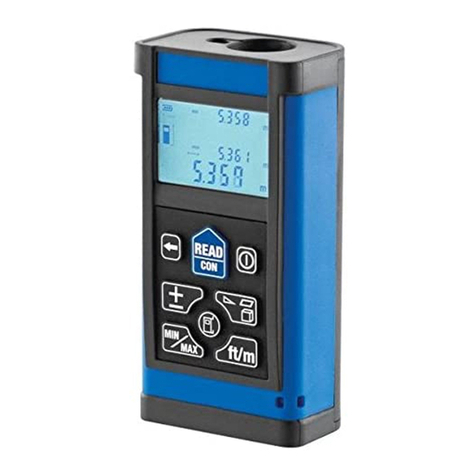
MasterCraft
MasterCraft LASER DISTANCE FINDER/MEASURING TOOL instruction manual
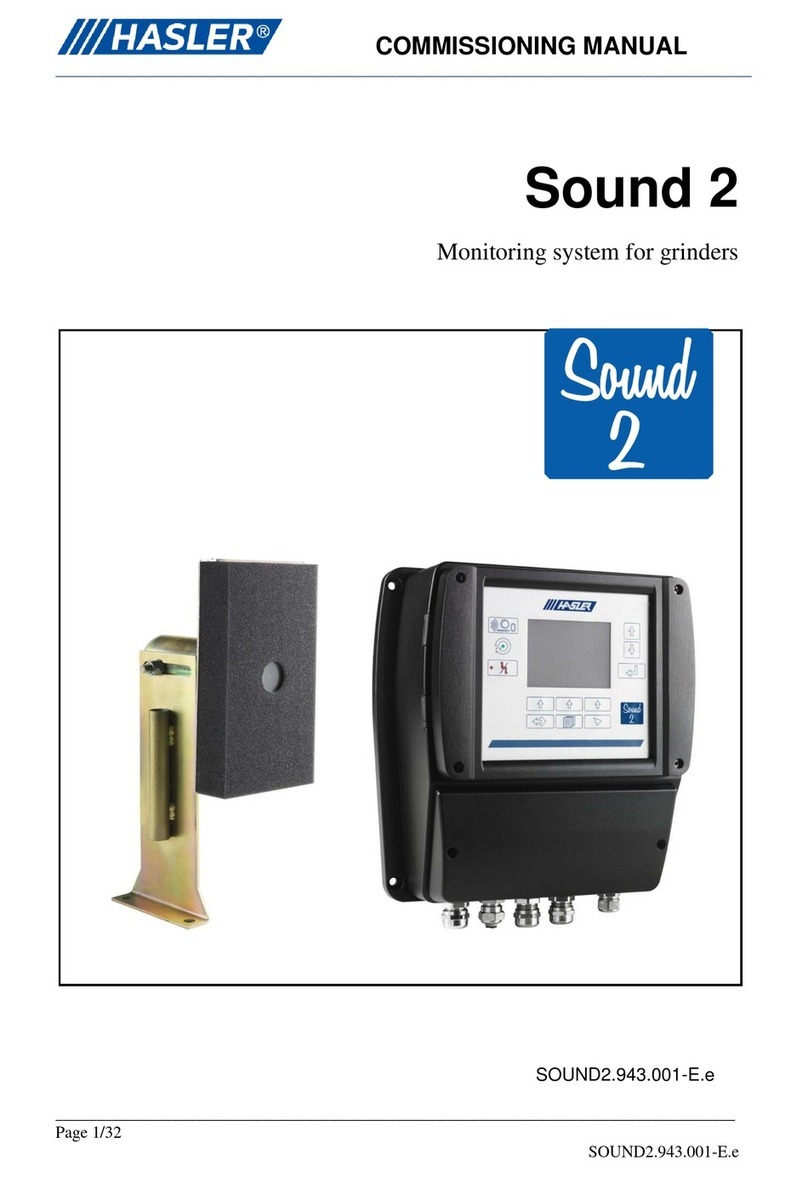
Hasler
Hasler Sound 2 Commissioning manual
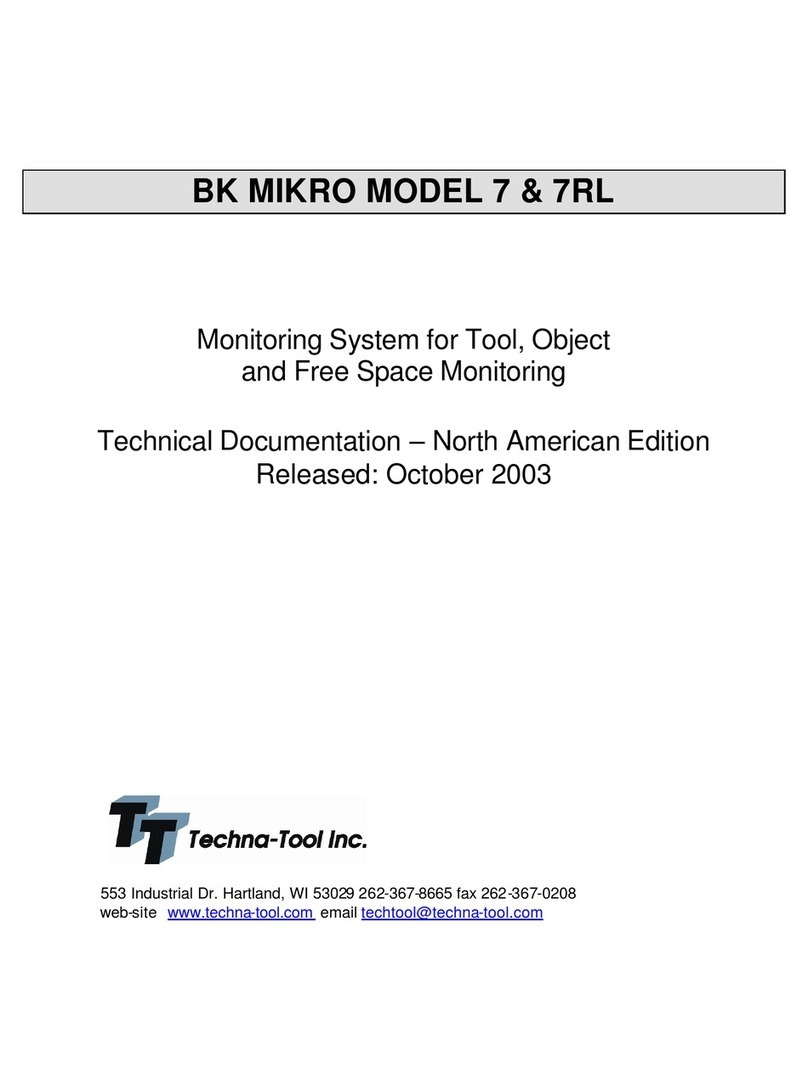
Techna-Tool
Techna-Tool BK MIKRO 7 Technical documentation

FujiFilm
FujiFilm FUJI DRI-CHEM IMMUNO AU CARTRIDGE vf-SAA Instructions for use

Milwaukee
Milwaukee MC310 user manual
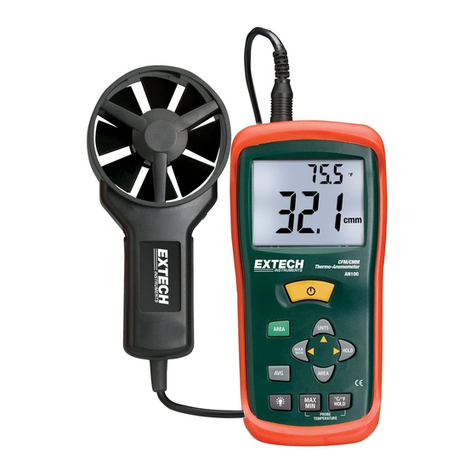
Extech Instruments
Extech Instruments AN100 user manual
